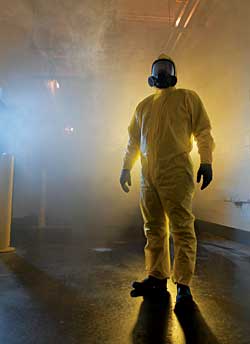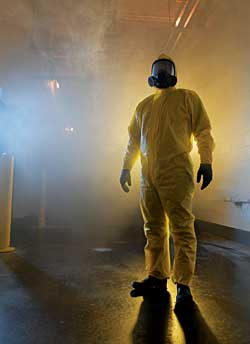
A Rising Tide
All boats at Kimberly-Clark Professional are lifted by its innovative "whole-person health" approach.
- By Jerry Laws
- Apr 04, 2007
 REACHING the pinnacle of safety success, world-class performance with a spotless injury log, can seem unattainable for any number of reasons. Deadlines, culture, turnover, upper management support, and resource shortages can set you back. Yet companies and workplaces achieve it again and again through passion, persistence, accountability, and empowerment. Today, those at the top of the safety pyramid are apt to go above and beyond in their outreach to employees' homes.
REACHING the pinnacle of safety success, world-class performance with a spotless injury log, can seem unattainable for any number of reasons. Deadlines, culture, turnover, upper management support, and resource shortages can set you back. Yet companies and workplaces achieve it again and again through passion, persistence, accountability, and empowerment. Today, those at the top of the safety pyramid are apt to go above and beyond in their outreach to employees' homes.
"This whole notion of worker compliance: Whether you're at home or whether you're at work, that still continues to be one of the biggest issues that you face," said Randy L. Kates, general manager, Safety Business for Kimberly-Clark Professional in Roswell, Ga. "The worker, or the person, the do-it-yourselfer working at home, just doesn't take the time--typically out of comfort or lack of convenience or whatever--to be safe when they're working. What we're all trying to do is continue to raise the awareness all the time of safety. Not when you're in a visibly hazardous environment, because that's typically when people are safe but that's not typically when people are getting injured. It's the common things, either at work or around the house, that still drive an awful lot of injuries."
The champion of at-home safety for Kimberly-Clark Professional is Scott Gaddis, whose actual title is Sector Safety Leader and who works in Owensboro, Ky. Gaddis, who is involved in the safety programs at 11 mills, described the company as being focused on "whole-person health." His push for 24-hour safety began as he looked for ways to address "satellite incidents" that really were peripheral to the work being done but nonetheless caused injuries--someone bumping into a object or falling out of a chair in an office, for example. More serious incidents could and did happen off the job.
"What we're all trying to do is continue to raise the awareness all the time of safety. Not when you're in a visibly hazardous environment, because that's typically when people are safe but that's not typically when people are getting injured." --Randy L. Kates, General Manager, Safety Business
What emerged was an effort to turn all of the workers into risk managers and a message that Kimberly-Clark was intent on complete safety and loss control--not just occupational safety, Gaddis said.
"You don't want to force information, especially to an employee that's leaving work, that's 'on his or her own time.' We really wanted it to become a best practice and what we would call a 'pull strategy,' " Gaddis said. "We tried to make it somewhat informal. . . . We didn't write a lot of rules about it. We didn't require employees to buy our service. We just generally offered the services to them and then created kind of a fun atmosphere for them to participate if they wanted to."
Contests, Libraries, PPE, and More
All of the mills host a Safety Week that invite the workers' families and offer programs on topics such as bicycle safety, home evacuation, fire safety, and home security programs. But each mill tailors its offerings; the company doesn't prescribe exactly how to run the program, said Gaddis, who mentioned one mill's hunting safety presentations and another's on safe boating.
"This whole thing is whole-person health," he reminded. "Most of our facilities have repositories of information for home safety. We keep a library on evacuation, on first aid, on babysitter safety techniques. We keep a lot of library information that the employees can check out from the facilities, take it home. We supply training materials for our employees to share with their families, and then we have fun and creative ways to recognize that."
It's not uncommon during Fire Safety Month for mills to run a poster competition for employees' children; their participation shows the management that the safety information it offers is indeed being disseminated to the families, Gaddis said.
Kimberly-Clark Professional gives away safety glasses, ear plugs, work gloves, and other PPE in that price range free for the taking to the employees. "If there are tasks that you're going to do at home that require you to be in PPE, we want you to take our equipment, and you go home with it," Gaddis explained. "It's simply from the fact that we know that if we don't lose you here [but] lose you at home, it's still going to affect the way that we do work. It's still going to cost money. . . . If you want to look at it from an economic standpoint, it's economically feasible to control that, even in the home. What we use it for is, again, to teach value: 'How can you turn safety off when you leave the workplace?' Well, you simply cannot."
"They leave work understanding that Kimberly-Clark cares enough about them to spend money on them not only at work, but on them when they leave work."
--Scott Gaddis, Sector Safety Leader
Most of the mills have a rule saying employees should wear steel-toed shoes while cutting the grass or weed-whacking at home. If they tear up those shoes in the line of duty at home, the company will replace them. "It tells us that you value yourself enough to wear that at home," said Gaddis.
Something more expensive, such as a fall harness, the company wants back so it can be inspected for wear and tear. But even these items are loaned out to employees with a pass, like checking out a book from a library.
This employer offers carbon monoxide tests for employees' families to ensure their heaters and gasoline-powered equipment are running right. Company doctors also conduct health screens for employees and their spouses.
On-the-Job Safety Benefits
Promoting safety at home pays off in greater safety when the employees are back at work, Gaddis and Kates agreed. "To me, success is when every single person in our facility goes home as safe as they came in," Gaddis said. "We try to coin a phrase here: We want them to be healthier when they leave. What does that look like? It kind of drives the type of program and process that we want to really put in place."
Injury rates and worker's compensation premium costs have fallen as some of the mills have achieved world-class safety performance. Kimberly-Clark Professional's Total Incident Rate was 0.7 at the end of 2006 versus 4.2 in 1996. Four mills (Loudon, Tenn.; Kobenz, Germany; Delyn, England; and San Antonio, Texas) had an injury-free year in 2005 or 2006.
"We're seeing great benefit with the programs we have in place. Off-the-job safety is not the only component you can nail that to, but certainly it helps us achieve that whole-person health concept and strategy that we have in place," said Gaddis.
What's next for the program? Gaddis said fostering better behaviors off the job is the next big challenge. This would be encouraging employees to work with their families at home to bring about safer teen driving habits, for example. One sign this might be achievable is the fact that several employees' children who've experienced the Kimberly-Clark Professional safety outreach have decided to pursue safety careers at college, Gaddis said.
"We knew, at the end of the day, that we would never be able to count all of the benefits that it would give us. That's probably the magic of this whole process: We know that we're going to see benefits. I don't know how much benefit, but I know it works," he said. "And from a pure employee satisfaction point, of our employees being engaged in our process, it really comes from the fact that they leave work understanding that Kimberly-Clark cares enough about them to spend money on them not only at work, but on them when they leave work."
This article appeared in the April 2007 issue of Occupational Health & Safety.
This article originally appeared in the April 2007 issue of Occupational Health & Safety.